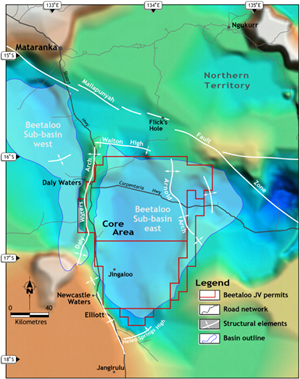Australia’s Shenandoah South project producing at rates seen in U.S. Marcellus shale, Falcon Oil & Gas reports
(WO) – Falcon Oil & Gas Ltd.’s Shenandoah South 1H (SS-1H) well in EP117 achieved above commercial IP60 flow rate of 3 MMcfd (normalized to 6 MMcfd over 1,000 m).
The SS-1H well in EP117 achieved an average 60-day initial production (IP60) flow rate of 3 MMcfd over the 1,644-foot (501 m), 10 stage stimulated length within the Amungee Member B-Shale, normalized to 6 MMcfd over 3,281-ft (1,000 m).
Exit rate trajectory after the 60 days of flow testing showed a steady low declining curve at 2.76 MMcfd over the stimulated length (normalised at 5.52 MMcfd per 3,281 ft) and stable reservoir back pressure of 530 psi.
The SS-1H IP60 flow test indicates that future development wells with lateral length of 10,000-ft (3,000 m) may be capable of delivering average rates of 18.4 MMcfd over the first 60 days of production.
Results to date confirm that this region, measuring more than 1 million gross acres below 8,850 ft (2,700 me), is one of the best locations in the Beetaloo basin to commence pilot development activities.
Flow testing of the SS-1H well will continue for the next 30 days to achieve average IP90 flow rates to better determine the well’s estimated ultimate recovery per well (EUR). IP90 flow rate results are expected to be announced in late April 2024.
The Beetaloo JV Partners of Falcon and Tamboran B2 Pty Limited will continue to progress development plans for the proposed 40 MMcfd Pilot Project at the Shenandoah South location.
The project is expected to require six 10,000-ft development wells initially to achieve plateau production of 40 MMcfd. Drilling of the first of these wells is planned to commence in Q2 2024, and the JV is targeting first gas in H1 2026.
Philip O’Quigley, CEO of Falcon, commented, “The SS-1H IP60 flow rate announced today of 3 MMcfd, normalized to 6 MMcfd over 1,000 m, demonstrates a steady low declining curve while holding its downhole pressure. This augurs well for the initial development in the Shenandoah South area as these rates continue to track average flow rates seen in the Marcellus Shale basin in the US.”



